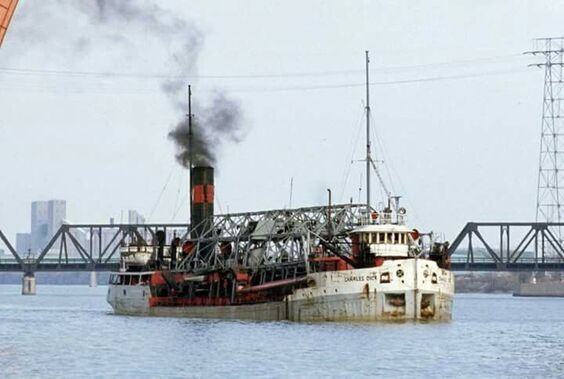Top Heavy
By James Donahue
The little steamer Henry Houghton made headlines the day it turned over in the Detroit River and sank, drowning two crew members sleeping below deck. It happened at 4:15 AM on September 9, 1902. The Houghton had arrived at Detroit only hours earlier with her hull deep in the water because of a heavy load of crushed stone brought from Marblehead, Ohio. The stone didn’t just fill the boat’s hold, but it was stacked high on the deck. It was obvious that the owners had this one hundred twenty-six-foot vessel loaded far beyond the weight capacity of one hundred fifty-one tons it was designed to carry. To intensify the weight, Capt. William Deeg said the boat came into heavy rail on Lake Erie, so the water was absorbed by the stone on the deck, adding even more weight at the top. In short, the boat was top-heavy.
Fortunately second engineer D. Anderson was up and stirring that morning while the rest of the crew slept below deck. Anderson noticed the vessel was starting to list and he knew there was going to be trouble. He stood in the pilot house, jerking the steam whistle cord to wake the crew and get everybody awake and scrambling for the deck. His action saved Captain Deeg, the ship’s cook, Mrs. Mary Neville and five others. Deek said he was helping Mrs. Neville step from the deck when the hawsers snapped from the strain. The steamer quickly rolled on its side and sank in twenty-two feet of water. Sailors Edward Close of Harbor Beach and William Daniels, address unknown, didn’t get out.
The Houghton later was raised and returned to service. The boat was sold to Winaford L. Emery in 1914 and Emery used it to haul sand. The Houghton was sold to the Service Gravel Company of Marysville, Michigan, in 1926 and converted for use as a sand sucker. It was ending a first season in this new role when a fire destroyed it on November 20.
The steamer was under the command of Capt. Robert B. Young when it burned and sank in the North Channel of the St. Clair Flats, just below Algonac, Michigan. Young and thirteen other crew members escaped in a lifeboat.
By James Donahue
The little steamer Henry Houghton made headlines the day it turned over in the Detroit River and sank, drowning two crew members sleeping below deck. It happened at 4:15 AM on September 9, 1902. The Houghton had arrived at Detroit only hours earlier with her hull deep in the water because of a heavy load of crushed stone brought from Marblehead, Ohio. The stone didn’t just fill the boat’s hold, but it was stacked high on the deck. It was obvious that the owners had this one hundred twenty-six-foot vessel loaded far beyond the weight capacity of one hundred fifty-one tons it was designed to carry. To intensify the weight, Capt. William Deeg said the boat came into heavy rail on Lake Erie, so the water was absorbed by the stone on the deck, adding even more weight at the top. In short, the boat was top-heavy.
Fortunately second engineer D. Anderson was up and stirring that morning while the rest of the crew slept below deck. Anderson noticed the vessel was starting to list and he knew there was going to be trouble. He stood in the pilot house, jerking the steam whistle cord to wake the crew and get everybody awake and scrambling for the deck. His action saved Captain Deeg, the ship’s cook, Mrs. Mary Neville and five others. Deek said he was helping Mrs. Neville step from the deck when the hawsers snapped from the strain. The steamer quickly rolled on its side and sank in twenty-two feet of water. Sailors Edward Close of Harbor Beach and William Daniels, address unknown, didn’t get out.
The Houghton later was raised and returned to service. The boat was sold to Winaford L. Emery in 1914 and Emery used it to haul sand. The Houghton was sold to the Service Gravel Company of Marysville, Michigan, in 1926 and converted for use as a sand sucker. It was ending a first season in this new role when a fire destroyed it on November 20.
The steamer was under the command of Capt. Robert B. Young when it burned and sank in the North Channel of the St. Clair Flats, just below Algonac, Michigan. Young and thirteen other crew members escaped in a lifeboat.
